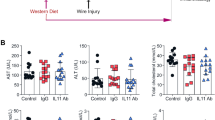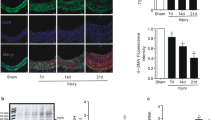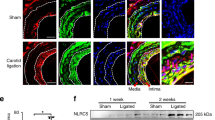Abstract
The transcription factor, NFkB, plays a pivotal role in the coordinated transactivation of cytokine and adhesion molecule genes involved in atherosclerosis and lesion formation after vascular injury. We hypothesized that synthetic double-stranded DNA with high affinity for NFkB may be introduced as a ‘decoy’ cis element to bind the transcription factor, and block gene activation, resulting in an effective therapeutic agent for treating intimal hyperplasia. In vivo transfection of NFkB decoy oligodeoxynucleotides (ODN) into balloon-injured rat carotid artery resulted in the inhibition of neointimal formation at 14 days after injury as compared with vessels transfected with scrambled ODN (P < 0.01). It is of importance to note that in the vessels transfected with NFkB decoy ODN, the expression of p53, a pro-apoptotic gene, was upregulated in neointimal area, followed by increased apoptosis at 14 days. In addition, gene expression of ICAM-1 and VCAM-1 was markedly decreased in blood vessels transfected with NFkB decoy ODN compared with scrambled ODN, whereas balloon injury induced ICAM and VCAM expression in the neointimal area. More importantly, the migration of macrophages and T-lymphocytes into the neointima and media was significantly inhibited by NFkB decoy ODN as compared with scrambled ODN. Here, we demonstrated that in vivo transfer of NFkB decoy ODN successfully inhibited neointimal formation after balloon injury, accompanied by (1) induction of apoptosis through p53 upregulation, and (2) inhibition of local inflammatory actions through the downregulation of adhesion molecules. These results suggest that decoy treatment against NFkB provides a new therapeutic strategy to inhibit neointimal hyperplasia after angioplasty.
This is a preview of subscription content, access via your institution
Access options
Subscribe to this journal
Receive 12 print issues and online access
$259.00 per year
only $21.58 per issue
Buy this article
- Purchase on Springer Link
- Instant access to full article PDF
Prices may be subject to local taxes which are calculated during checkout







Similar content being viewed by others

References
Gibbons GH, Dzau VJ . The emerging concept of vascular remodeling N Engl J Med 1994 330: 1431–1438
Lefkovits J, ToJournalpol EJ . Pharmacological approaches for the prevention of restenosis after percutaneous coronary intervention Prog Cardiovasc Dis 1997 40: 141–158
Haunstetter A, Izumo S . Apoptosis: basic mechanisms and implications for cardiovascular disease Circ Res 1998 82: 1111–1129
Geng YJ, Libby P . Evidence for apoptosis in advanced human atheroma: colocalization with interleukin-1β converting enzyme Am J Pathol 1995 147: 251–266
Bennett MR, Evan GI, Schwartz SM . Apoptosis of human vascular smooth muscle cells derived from normal vessels and coronary atherosclerotic plaques J Clin Invest 1995 95: 2266–2274
Han DKM . Evidence for apoptosis in human atherogenesis and in a rat vascular injury model Am J Pathol 1995 147: 267–277
Isner JM, Kearney M, Bortman S, Passeri J . Apoptosis in human atherosclerosis and restenosis Circulation 1995 91: 2703–2711
Epstein SE . The role of infection in restenosis: focus on cytomegalovirus Lancet 1996 348: 13–17
Qin ZH, Wang Y, Nakai M, Chase TN . Nuclear factor-kappa B contributes to excitotoxin-induced apoptosis in rat striatum Mol Pharmacol 1998 53: 33–42
Wang CY . NF-kappaB antiapoptosis: induction of TRAF1 and TRAF2 and c-IAP1 and c-IAP2 to suppress caspase-8 activation Science 1998 281: 1680–1683
Boucier T, Sukhova G, Libby P . The nuclear factor-κB signaling pathway participates in dysregulation of vascular smooth muscle cells in vitro and in human atherosclerosis J Biol Chem 1997 272: 15817–15824
Brand K . Activated transcription factor nuclear factor-κB is present in the atherosclerotic lesion J Clin Invest 1996 97: 1715–1722
Landry DB, Couper LL, Bryant SR, Lindner V . Activation of the NF-κB and I-κB system in smooth muscle cells after rat arterial injury: induction of vascular cell adhesion molecule-1 and monocyte chemotactic protein-1 Am J Pathol 1997 151: 1085–1095
Cercek B . Nuclear factor-κB activity and arterial response to balloon injury Atherosclerosis 1997 131: 59–66
Bellas RE, Lee JS, Sonnenshein GE . Expression of a constitutive NF-κB-like activity is essential for proliferation of cultured bovine smooth muscle cells J Clin Invest 1995 96: 2521–2527
Selzman CH . Liposomal delivery of purified inhibitory-κBα inhibits tumor necrosis factor-α-induced human vascular smooth muscle proliferation Circ Res 1999 84: 867–875
Erl W . Nuclear factor-κB regulates induction of apoptosis and inhibitor of apoptosis protein-1 expression in vascular smooth muscle cells Circ Res 1999 84: 668–677
Weber C, Erl W, Pietsch A, Weber PC . Aspirin inhibits nuclear factor-κB mobilization and monocyte adhesion in stimulated human endothelial cells Circulation 1995 91: 1914–1917
Weber C . Antioxidants inhibit monocyte adhesion by suppressing nuclear factor-κB mobilization and induction of vascular cell adhesion molecule 1 in endothelial cells stimulated to generate radicals Arterioscler Thromb 1994 14: 1665–1673
Ledebur HC, Parks TP . Transcriptional regulation of the intercellular adhesion molecule-1 gene by inflammatory cytokines in human endothelial cells J Biol Chem 1995 270: 933–943
Yasukawa H . Inhibition of intimal hyperplasia after balloon injury by antibodies to intercellular adhesion molecule-1 and lymphocyte function-associated antigen-1 Circulation 1997 95: 1515–1522
Tomita N, Morishita R, Higaki J, Ogihara T . Strategy for functional inactivation of genes: a novel strategy for gene therapy and gene regulation analysis using transcriptional factor decoy oligonucleotides Exp Nephrol 1997 5: 429–434
Morishita R, Higaki J, Tomita N, Ogihara T . Application of transcription factor ‘decoy’ strategy as means of gene therapy and study of gene expression in cardiovascular disease Circ Res 1998 82: 1023–1028
Morishita R . In vivo transfection of cis element ‘decoy’ against nuclear factor-κB binding site prevents myocardial infarction Nat Med 1997 3: 894–899
Tanaka H . Sustained activation of vascular cells and leukocytes in the rabbit aorta after balloon injury Circulation 1993 88: 1788–1803
Wadgaonkar R . CREB-binding protein is a nuclear integrator of nuclear factor-kappaB and p53 signaling J Biol Chem 1999 274: 1879–1882
Grimm S, Baeuerle PA . The inducible transcription factor NF-κB: structure–function relationship of its protein subunits Biochem J 1993 290: 297–1882
Collins T . Endothelial nuclear factor-κB and the initiation of atheroscrelotic lesion Lab Invest 1993 68: 499–508
Henkel T . Intramolecular masking of the nuclear location signal and dimerization domain in the precursor for the p50 NF-κB subunit Cell 1992 68: 1121–1133
Henkel T . Rapid proteolysis of IκBα is necessary for activation of transcription factor NF-κB Nature 1993 365: 182–185
Lawrence R . Vascular smooth muscle cells express a constitutive NF-κB-like activity J Biol Chem 1994 269: 28913–28918
Tomita N . Transcription factor decoy for NFkB inhibits TNF-α-induced IL-6 and ICAM-1 expression in endothelial cells J Hypertens 1998 16: 993–1000
Bennett MR, Evan GI, Schwartz SM . Apoptosis of rat vascular smooth muscle cells is regulated by p53-dependent and -independent pathways Circ Res 1995 77: 266–273
Aoki M . Inhibition of the p53 tumor suppressor gene resulted in growth of human aortic vascular smooth muscle cells (VSMC): potential role of p53 in regulation of VSMC growth Hypertension 1999 34: 192–200
Lane DP . p53, guardian of the genome Nature 1992 258: 15–16
Miyashita T, Harigai M, Hanada M, Reed JC . Identification of a p53-dependent negative response element in the bcl-2 gene Cancer Res 1994 54: 3131–3135
Miyashita T, Reed JC . Tumor suppressor p53 is a direct transcriptional activator of the human bax gene Cell 1995 80: 293–299
Desmouliere A, Redard M, Darby I, Gabbiani G . Apoptosis mediates the decrease in cellularity during the transition between granulation tissue and scar Am J Pathol 1995 146: 56–66
Morishita R . Role of AP-1 complex in angiotensin II-mediated transforming growth factor-β expression and growth of smooth muscle cells using decoy approach against AP-1 binding site Biochem Biophys Res Commun 1998 243: 361–367
Morishita R . Novel intraluminal molecular delivery of antisense cdc2 kinase and PCNA oligonucleotide results in chronic inhibition of neointimal hyperplasia Proc Natl Acad Sci USA 1993 90: 8474–8478
Morishita R . Intimal hyperplasia after vascular injury is inhibited by antisense cdk 2 kinase oligonucleotides J Clin Invest 1994 93: 1458–1464
Kaneda Y, Iwai K, Uchida T . Increased expression of DNA cointroduced with nuclear protein in adult rat liver Science 1989 243: 375–378
Gavrieli Y, Sherman Y, Ben-Sasson SA . Identification of programmed cell death in situ via specific labeling of nuclear DNA fragmentation J Cell Biol 1992 119: 493–501
Acknowledgements
This work was partially supported by a grant from the Japan Health Sciences Foundation, a Grant-in-Aid from The Ministry of Public Health and Welfare, a Grant-in-Aid for the Development of Innovative Technology, a Grant-in-Aid from Japan Promotion of Science, and Special Coordination Funds of the Ministry of Education, Culture, Sports, Science and Technology, the Japanese Government.
Author information
Authors and Affiliations
Rights and permissions
About this article
Cite this article
Yoshimura, S., Morishita, R., Hayashi, K. et al. Inhibition of intimal hyperplasia after balloon injury in rat carotid artery model using cis-element ‘decoy’ of nuclear factor-kB binding site as a novel molecular strategy. Gene Ther 8, 1635–1642 (2001). https://doi.org/10.1038/sj.gt.3301566
Received:
Accepted:
Published:
Issue Date:
DOI: https://doi.org/10.1038/sj.gt.3301566
Keywords
This article is cited by
-
Nuclear Factor-κB is Activated in Filter-Implanted Vena Cava
CardioVascular and Interventional Radiology (2019)
-
Dilated cardiomyopathy update: infectious-immune theory revisited
Heart Failure Reviews (2013)
-
Regulations of the key mediators in inflammation and atherosclerosis by Aspirin in human macrophages
Lipids in Health and Disease (2010)
-
Decoy oligodeoxynucleotide targeting activator protein-1 (AP-1) attenuates intestinal inflammation in murine experimental colitis
Laboratory Investigation (2008)
-
Inflammatory events in a vascular remodeling model induced by surgical injury to the rat carotid artery
British Journal of Pharmacology (2006)


